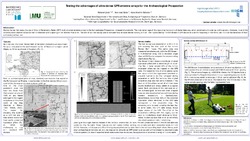Testing the advantages of ultra-dense GPR antenna arrays for the Archaeological Prospection
2022Konferenzbeitrag
Englisch
Linck, Roland; Stele, Andreas; Schuler, Hans-Martin, 2022: Testing the advantages of ultra-dense GPR antenna arrays for the Archaeological Prospection. DOI: https://doi.org/10.23689/fidgeo-5331.
 |
Dokument öffnen: |
During the last few years, the use of Ground-Penetrating-Radar (GPR) multi-channel antenna arrays in the Archaeological Prospection increased dramatically. The main advantage of this type of survey is a much faster data acquisition combined with a dense profile spacing. However, most of the common multi-channel arrays consist of antennae with a spacing of not smaller than 8 cm. The aim of our test survey was to evaluate how an even denser spacing of 4 cm that is provided by the IDS Stream-C GPR device at a centre frequency of 600 MHz can improve the detection of small archaeological features.
As a test site, we chose the Great Bath in Kempten-Cambodunum. This first capital of the Roman province Rhaetia never has been overbuilt in the following centuries and even today it is used as a grassland declared as an Archaeological Park. Already in 1911, the Great Bath was excavated and beside the walls of different building phases, also small features like a multitude of hypocaust pillars were unearthed. Hence, this building structure depicts an ideal test site and a 40x40m grid covering the main part of the construction was chosen for the application of the antenna array. As a comparison, the same grid was contemporaneously surveyed with a single antenna IDS Duo device (600 and 200 MHz) and a 50 cm profile spacing.
Regarding the walls of the Roman bath, the two surveys show comparable results: both datasets represent the stone constructions of 50 – 90 cm width quite well. Furthermore, the depth slices of both devices provide a differentiation of the single building phases. Nevertheless, the resolution for the multi-channel antenna array is of course much higher due to the denser profile spacing. Huger differences occur for the hypocaust pillars of 25 cm lateral length. These features can be mapped in detail with the 4 cm profile spacing of the IDS Stream-C system. Whereas the IDS Duo can only resolve some of the hypocausts, a multitude of them gets visible between 70 and 110 cm depth in the Stream-C data.
As a conclusion, it can be stated that standard archaeological remains like stone walls, for sure, can be surveyed with single antenna GPR devices in a common profile spacing of 50 cm. However, in case of the existence of faint archaeological features the application of ultra-dense antenna arrays like the IDS Stream-C is advisable to get a comprehensive overview of a site without the necessity to excavate them.

